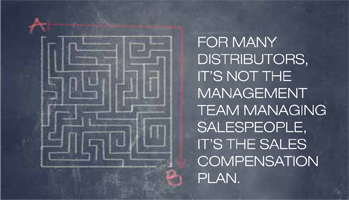The Path to Greater Profits

by Brent Grover
Many distributors fail to understand the profit potential of their company. It’s like the story about the worm that’s in the jar of mustard and thinks the whole world is mustard. Many distributors have been in the game for so long that they feel there are limitations on how much money their business can make, and they’re willing to accept years in which they don’t make money. They not only misunderstand their profit potential, they don’t understand why they’re unable to reach their potential.
I often tell clients they should be looking for a 20 percent pre-tax return on investment in their distribution business. Many don’t believe it. Yet other distributors achieve and even exceed that goal.
Obviously, most of them don’t generate a 20 percent return on investment year in and year out. But occasionally they do. Wholesale distribution is a risky business. There are very low barriers of entry and exit. Because our businesses tend to be localized in the key markets where we operate, a competitor can enter a market where we’ve done well and can destroy the profitability of that market. If they have deep enough pockets, they can destroy profitability of that market for a very long time.
As owner managers, we’re entitled to be compensated for the capital we put at risk and for the hard work we put into the business.
Many distributors earn more than a 20 percent pre-tax ROI in their business virtually every year. If you don’t believe that, pick up an annual report for W. W. Grainger and look at the type of return on sales and the return on investment they generate. Then ask yourself, why did they do that? Why do I not do that?
Shorten your path to profit
The shortest path to profitability improvement for established distributors is to look at your current customer base and figure out how you and your customers can make more money together. I’m not talking about squeezing profits out of customers while they’re not looking. It’s a question of trying to make the distributor more profitable and helping customers at the same time.
One of my favorite quotes comes from Picasso, who was certainly a great painter, but who also was a philosopher who lived from the beginning of the last century all the way into the computer age. Picasso said, “Computers are useless. They can only give you answers.”
Distributors who live in the world of big data still have to be able to ask the right questions. The computer can only give you answers.
Ask yourself, how can we, as a distributor, make an improvement in our profitability in a very sluggish recovery? The only way you are going to gain sales is by increasing market share, which means taking business away from your competitors. That comes at a cost. In the short term you take on business that isn’t very profitable, with the hopes to improve profitability later.
The shortest route to profitability now is to make more money with your current customers. You do that by asking the right questions.
Your CEO and the CEO’s team need to ask questions such as: Why do we lose money selling to some of our largest customers? How can we turn that around? Why is return on sales for some of our sales territories so good, while other sales territories are at or below break-even point? What’s our return on sales from each customer segment, and why are some customer segments profitable, but we lose money on others?
The answer is because you’re offering below-market pricing to small and very small customers. The computer can give you answers to those questions, but you have to ask the right questions.
Think of it as a holistic approach. Strategic pricing has been very popular over the last 20 years with wholesale distributors. If it were easy, everyone could just raise all their prices 2 percent and all the customers would say that’s great and everybody would make more money in distribution.
Obviously, that doesn’t work. The way strategic pricing works for some companies is just a variation of that approach: let’s raise our prices and see what happens. Instead, you should look at your customers to see who’s profitable and who isn’t and why that is true. Sometimes it’s because of pricing. If you’re at below-market pricing with the customer, you want to raise it, at least gradually.
Maybe the problem isn’t pricing. Maybe it’s order size. Even very large customers who place a zillion small orders are unprofitable for a distributor.
Finally, it’s the question of cost-to-serve, which depends, in part, on order size. Cost-to-serve includes all of the costs to get orders from this customer, including sales and sales support, office, handling, delivery and overhead. Finally, how much does it cost to get paid?
All of those areas are under attack because the role of sales people has changed so much and because personal selling, while important, is expensive. It’s not for every situation. Distributors answer every question their customers ask with the same answer. They say, “Yes.”
“I want a sales person.” “Sure.”
“I need it today.” “Great.”
“I’m going to pay you with a credit card.” “Okay.”
Those are all cost-to-serve elements that drive down profitability. Cost-to-serve has to do with the cost of selling, the cost of delivery, and the cost of getting paid, and it’s driven by the most profound indicators of distributor profitability, customer profitability and order profitability, which is order size.
 Below-market pricing
Below-market pricing
I often ask distributors how they determine pricing at their company. They usually say, “We give our sales people the cost of our products and a price book, but they all know it’s not realistic. It’s not up to date. It’s not specific to customer segments. It’s our list price, but nobody really sells at that price.”
Then I ask, “How do your sales people come up with a price?” “Well, they use the cost and then they talk to the customer and the customer will tell them what competitors are charging. Our pricing strategy is we’ll meet the price or we’ll beat the price and then we’ll fix it later. That’s our pricing strategy in our business.”
The sales people don’t have any idea what market-driven prices really are. They just know the cost of their products.
Unfortunately, you can’t find a reliable outside source to tell you how much your customers are paying your competitors. You’re not in the consumer products goods business where you can buy that information from a data harvesting company. You have to get that information from your own computer system. How do you do that? If you sort the data by customer segment, customer size, you know how much your customers are paying you for the products they buy from you. Those are market prices.
You can organize that information. You can use data analytics to identify which products are sold below market to which customers. Then you can fix the outliers. Using customer profitability information, you know where to look for the opportunities. Also, you can create pricing matrices that will charge customers market prices going forward so the sales people don’t have to guess. You already own the data. You just need to ask the right questions.
SMART pricing
SMART pricing is Sustainable, Measurable, Actionable, Realistic, and Time sensitive. Distributor sales people today have fantastic product knowledge, presentation skills, and closing skills. They know how to get the order. Where they usually are not well prepared is in the area of negotiating because they don’t have information. Good negotiators can come up with a winning proposition for themselves and for their customer. The information they are missing is market-driven pricing information. All they know is the cost of the product. What they don’t know is the value of their product and service to this customer. What are other customers like this customer paying for this item or an item just like it? That’s the right question. That’s the market price.
Salespeople often have customers who say, “Well, you know, your price is a little high. You’ve got to come down. You have to sharpen your pencil.” The sales person must be able to say, “This is what other customers in the market pay us for this. If I’m going to give you a concession, and I’d really like to because I can see how important that is to you, I need to ask you to do something for me. Can you give me an order for a hundred? Can you give me a year contract? Can you give me some additional business that we’re not currently getting? If you could give me that other business that I don’t have, I could probably give you a better price on everything you buy from me.”
In order to have that conversation, however, you must understand your market.
Those of us who have been swimming in that jar of mustard all these years have learned to focus on gross margin percentage because that’s how we pay our sales people. We’ll write a check for a commission on an order that loses money. How do I know that? Because I ask distributors the question, what is the minimum threshold of gross margin dollars that your sales person has to earn on an order in order to earn a commission?
Their answer is usually, “I don’t think we do that,” or, “Oh, it’s $25.”
“How much does it cost you to process an order at your company?”
“Well, I don’t really know,” or they’ll answer, “Well, $75.” I say, “It costs you $75 to process an order, but you pay your sales people an incentive to bring in an order that only generates $25. Aren’t you giving them an incentive to lose money for your company?”
A very small change in the sales compensation plan, to implement a threshold of gross margin dollars, can have a major impact on profitability.
How does that relate to order size? Gross margin percentage times the sales dollar amount equals the gross margin dollars. If I have a really big order, I can handle low margin percentages at my company. I can be competitive with anybody if I have the order size that I need to make money. If the distributor is focusing on smaller customers who place smaller orders, they need to rethink their cost structure.
I’m not trying to beat up on salespeople. Management is paying sales people to do something that they really don’t want them to do. They’re paying them to bring in unprofitable orders. The sales people are asked to set pricing without knowing the market pricing.
All managers and leaders must build trust with their sales teams. The only way to do that is through strong, two-way communication. You have to communicate with the sales people. It baffles me when some companies are very secretive with their sales people about so many aspects of the business. They don’t tell them the basic facts they need to know to understand why the customer is profitable, why an order is profitable, and how do I as a sales person make more money?
The other thing managers fail to do is give sales people the market-driven pricing information they need to win with their customers. It’s not the management that’s managing the sales team. It’s the sales compensation plan at so many distributors. They use a straight commission compensation plan, and they think of that as being the sales manager.
Regrettably, with all the improvements that have been made in wholesale distribution productivity, the sales reps are the most under-invested group and the most lightly managed group.
When I am in a meeting with a distribution sales team, I like to ask them to write down their company’s sales pricing strategy. Some will say, “We meet the competition. We beat the competition.” The most popular answer is usually, “We don’t have a pricing strategy.”
The right answer is to say, “We sell based on value. We know what the market is and we use our knowledge of the market to come up with market-driven pricing that’s based on value.”
 Brent Grover is founding partner of Evergreen Consulting, advisors to distribution channel distributors, suppliers and trade associations on pricing optimization, strategic planning, acquisitions and profit improvement. He can be reached at (216) 360-4600, ext. 101, at brent@evergreenconsulting.com or at www.evergreenconsulting.com.
Brent Grover is founding partner of Evergreen Consulting, advisors to distribution channel distributors, suppliers and trade associations on pricing optimization, strategic planning, acquisitions and profit improvement. He can be reached at (216) 360-4600, ext. 101, at brent@evergreenconsulting.com or at www.evergreenconsulting.com.
This article originally appeared in the May/June 2017 issue of Industrial Supply magazine. Copyright 2017, Direct Business Media.












